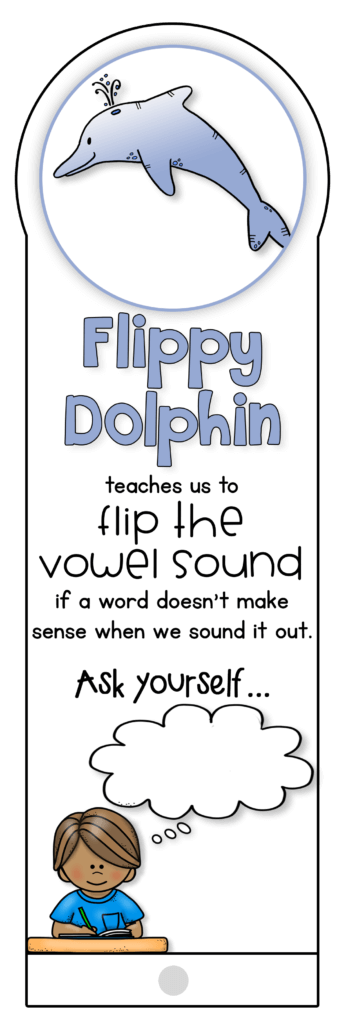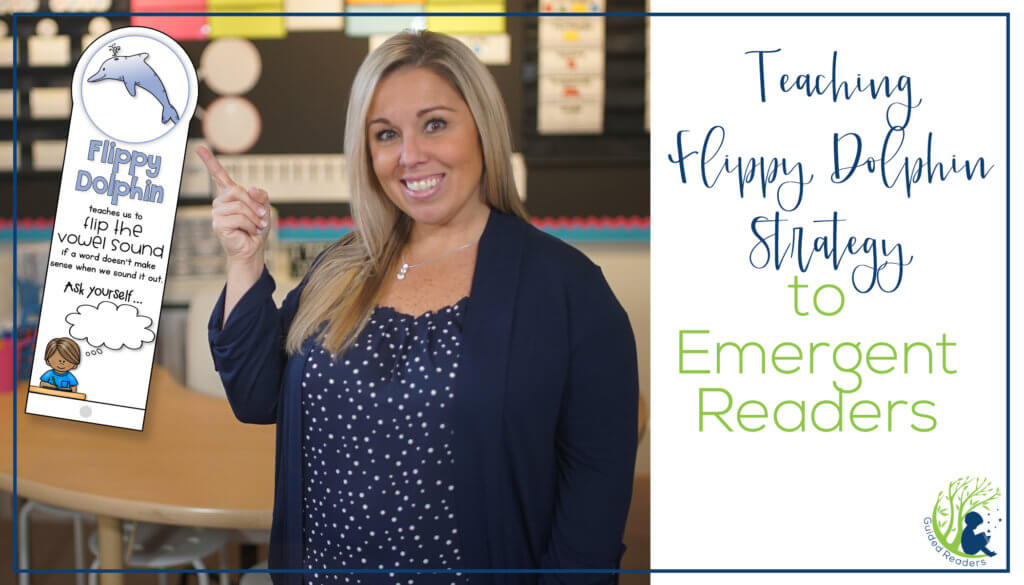What decoding strategies should you be teaching your Early readers? The students in your Early Readers leveled group are already familiar with Lips the Fish, but now they’re ready to meet her more adventurous big sister, Flippy Dolphin! The Flippy Dolphin strategy provides a great way for your students to solve words with long or short vowel sounds. In this post, we’ll talk about the best ways to teach the Flippy Dolphin decoding strategy.
The Adventures of Flippy Dolphin

Let’s face it, dolphins are awesome. They’re sleek and smart and full of curiosity. And our friend Flippy is no exception! She’s brave, smart and curious, as evidenced by what she does as she’s learning to read. If a word doesn’t make sense to Flippy, or if it doesn’t sound right, she’s not afraid to FLIP the vowel sound to see if it helps solve it. “Versatility, thy name is Flippy!”
Flippy can be such a helpful friend to your little readers; so if you’re ready to introduce the Flippy Dolphin reading strategy to your Early Readers group, then read on!
Early Readers are Ready to Meet Flippy Dolphin!
Early Readers are reading on levels D through H/I, and they’re learning sight words and high-frequency words. They’re also beginning to tackle two-syllable and even some three-syllable words. They’ve learned many of the predictable spelling patterns; and they’re beginning to learn to solve words with regular letter-sound relationships. Early readers know enough about words to be able to use Flippy Dolphin as an effective word-solving strategy when needed.
Flippy Dolphin gives readers another option for knowing the next step to take when they read a word and find that it doesn’t make sense or doesn’t sound right. The strategy involves the use of the Graphophonic or Visual cues students see as they look at the printed letters of a word.
When you’re ready to teach the Flippy Dolphin strategy, be sure to display a cute stuffed dolphin to grab your kiddos’ attention. You’ll also need to provide strategy fans that your students can refer to throughout the lesson. All of the lessons in my Guided Readers online guided reading program contain strategy fan templates as well as a strategy instruction booklet to guide you as you teach.
“Vowels, Meet Flippy. Flippy, Meet the Vowels!”
To introduce Flippy Dolphin, start by saying, “Boys & girls, I want you to meet our new friend, Flippy Dolphin! Now, Flippy is GREAT at doing flips! Sometimes she reads a word that doesn’t make sense; but when that happens, she FLIPS the vowel sound to see if that helps the word make better sense. Let’s be like Flippy Dolphin and try to flip the vowel sounds in some words to see how this strategy can help us.”
Next, read a passage from a big book, and mispronounce a familiar CVC or VCE word. Then FLIP the vowel sound to read it correctly. Use chart paper or a Smartboard to teach and model the Flippy Dolphin strategy with other words. Write a couple of short sentences and then read them, mispronouncing a long or short vowel sound in a word or two.
Say something like, “She likes to jump rop. Wait, boys & girls–did that sound right? No! And it didn’t make sense, did it? Let’s use our Flippy Dolphin strategy to flip the vowel sound. We said “rop,” with a short vowel sound. But let’s see what happens if we flip the “o” from a short vowel sound to a long vowel sound: ‘She likes to jump rope.’ That’s it! Remember, the magic-e at the end means the vowel sound is long, so the vowel says its name: ’o.’ Let’s read that word again with the long vowel sound this time: ‘rope.’ ‘She likes to jump rope.’ Ahh…that’s better, isn’t it?”
Batting Practice…
Give your kiddos plenty of examples of the use of this strategy. Say, “Now Let’s try another one. I’ll read it and you tell me if Flippy can help. “He has a new bate and ball.” Oh, you’re right! ‘Bate’ doesn’t sound right, and it doesn’t make sense! But let’s see if flipping the vowel sound from long to short will help. Instead of the long-a sound in ‘bate,’ let’s flip it around to a short-a sound: ‘bat.’ Yes! that fixed it so it sounds right and makes sense. ‘He has a new bat and ball.’ Wow, Flippy Dolphin can really help us a lot when we don’t know a word, can’t she?”
Teach the Flippy Dolphin Strategy in Guided Reading Small Groups

While a whole class lesson is a great way to introduce Flippy Dolphin, you should also reinforce it during your Guided Reading small group. Let’s look at how you might teach Flippy Dolphin using my book, The Case for Carrots. (This is a Level-E book that’s available within Guided Readers, my new online guided reading program. I’ll share more about Guided Readers later in this post.)
After the Read & Prompt and book discussion, have your students use their strategy fans to refer to the Flippy Dolphin strategy as you read page one together. Remind them to use Flippy Dolphin to help them fix a word that doesn’t sound right or doesn’t make sense. Read the sentence like this, “I hat carrots!”
Then ask the students, “Wait a minute–‘hat’?!! That didn’t sound right, did it? Let’s try using Flippy Dolphin to FLIP the vowel sound in that second word. Instead of the short vowel sound, ‘hat,’ let’s change it to the long vowel sound: ‘hate.’
My Apologies to Carrot Haters…But It Really Does End Happy
“‘H-a-t-e,’ ‘hate.’ Yes! That makes more sense! ‘I hate carrots!’ Oh, that’s too bad! Let’s keep reading to see if he might change his mind about carrots. And let’s remember to use the Flippy Dolphin strategy whenever we need it.”
Use the strategy for a couple more words and then turn to page 8 and mispronounce the long-a vowel sound in cake. (“I had them in cak.”)
Next, say “Whoa, hold on a minute! ‘Cak’ didn’t sound right, did it? There’s a magic-e at the end of the word, so let’s flip that first vowel sound and make it a long-a. ‘Cake.’ Now that sounds delicious! It sounds right and it makes sense with the picture we see! See how Flippy Dolphin can help us read words with vowel sounds?”
Be sure to encourage your students to use the other strategies they’ve learned, such as Eagle Eye, Lips the Fish, Chunky Monkey and Stretchy Snake. Remind them to check their strategy fans to see if there’s a strategy they can use when they come to a word they don’t know.
Meet Guided Readers…
Now that you’ve given your students another helpful strategy, let me ask you: “What’s yours?” Do you have an effective strategy for staying afloat in your literacy instruction? There’s a sea of information out there, but do you ever feel like there’s just never enough time?
That’s the reason I created Guided Readers, your complete, done-for-you tool for teaching! Guided Readers takes the guesswork out of what to teach and how, with engaging, professionally leveled texts, complete, done-for-you lesson plans, a digital interactive reader, and time saving tools to help you stay organized. Guided Readers is a structured approach designed for today’s real classroom! It contains every effective tool you’ll need to take your students from “learning to read” to “reading to learn!”
Thanks for stopping by the blog and enjoying this quick overview of the Flippy Dolphin strategy. Click these links to view them if you missed my other posts on Eagle Eye, Lips the Fish, Chunky Monkey and Stretchy Snake.
Or head on over to my YouTube channel to watch how I implemented Flippy Dolphin on my latest video, just click the image below:
Keep teaching those strategies, and like Flippy, learn the value of versatility! ; )
Hugs,
Anna


